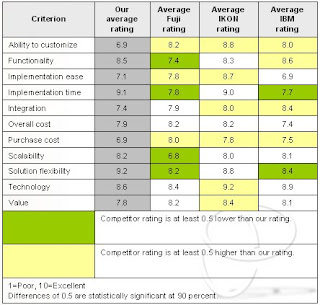The Compartmentalization of Competitive Intelligence in a Company
Over the past couple of weeks, I have spent some time on the phone talking with a number of our current and past clients. What a great experience this has been. I am reminded of the great people that have chosen to work with Primary Intelligence.
The goal of these conversations has been to understand a little bit more about how companies use our intelligence. At Primary Intelligence, we have a strong value proposition and we’re pretty good at communication the message. To us, the true value of what we do is obvious. The list of people in a company that should benefit from our services is well defined. In other words, we’re a simple plug-in solution that solves a set of problems and provides an expected value.
All of which is true to some extent. But, the real fun has been to find out all those little nuances of use, value and such that come into existence within each of our clients’ corporate environments and cultures. We have some very creative clients that are finding bigger and better ways to leverage their intelligence to create more value. We also have a few that are looking forward to a summary of my findings as a “thank you” for their willingness to spend time with me.
Something that is coming out in many of my conversations, however, is the fact that intelligence often has a tendency to be compartmentalized. By this, I mean that there is a tendency for the intelligence to be consumed by a single person or group of people for strategic planning and tactical to-dos, but other departments are often left in the dark regarding the presence of win loss feedback.
Some of the most interesting examples of this compartmentalization occur between sales and marketing. (Can’t we all just get along?) When sales intelligence is purchased by sales, sales operations or sales training, there is often a reluctance to share the data throughout the organization. The intelligence is used by the sales group to accomplish their designs, but marketing, product or corporate executives often do not receive information.
Even more interesting is the reaction from the marketing side. In numerous cases, marketing has told me that they use the win loss data to answer questions about marketing and product. They even put pieces of our intelligence into presentations that are delivered to the executive boardroom. But, when asked about how the sales team uses the intelligence, a long silence happens and then they ask, “What would sales want with this information?”
Personally, I would have thought sales would be eminently interested. But, from some points of view within a company, they can’t see what a sales leader or rep needs to be more successful.
Caveats: We do have plenty of clients that share between sales, marketing, product and others. These phone calls are not a scientific measure. These conversations are as relevant as one-offs on any topic. Some companies use intelligence more effectively than others. Most sales and marketing groups work together to coordinate their intelligence needs. A win loss project doesn’t mean the same thing to every company in every industry.
That said, it is my observation that our clients that create a processes to accept, digest, understand, distribute and act on sales intelligence tend to be leaders in their respective industries. I’m sure that many of these companies have an overall culture that is accustomed to using research, data and intelligence of many types. The fact that they can process our information is the result of a leadership group that expects all leaders to be more fact-based.
What is the takeaway? You might want to look at your company culture and plans for 2008. What types of competitive intelligence are you generating? Does your CI program have ROI potential? How far does it travel and are there any real expectations that the information will be used to make a revenue-enhancing decision (increased sales success, better market positioning, increased competitive strength, faster time to market, etc…)?
What can you do to gain one more champion of your competitive intelligence efforts? Can you reach out to another department and make a friend? Can you find others within your company that are willing to receive your data? How willing are you to listen to other research performed by other departments in your company?
Personally, I believe that the good intelligence should rise above the clutter to the top and it should be used as often as possible, as long as it is relevant, to strengthen the company. Otherwise, the overall value is marginalized.
Progress starts with one person trying to make something a little better. Are you the person to break down some of the compartmentalization of your company?








